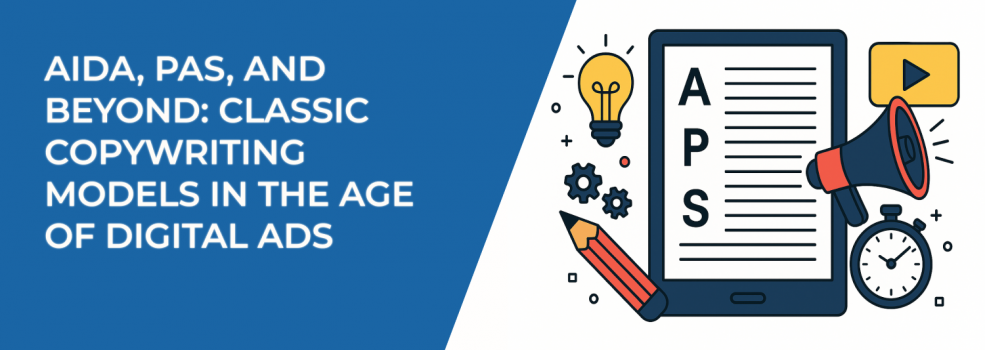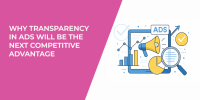Digital advertising changes quickly. Platforms update, algorithms shift, and users scroll faster than ever. Yet one thing doesn’t change: people still respond to messages in predictable ways. That’s why copywriting frameworks like AIDA and PAS continue to work, even in modern campaigns.
These models weren’t built for Facebook or Instagram, but they adapt well. In fact, they can give structure to ads in a space where attention is scarce. Let’s look at how they work, and then explore newer variations that fit digital formats.
AIDA: Attention, Interest, Desire, Action
The AIDA model is a simple formula that guides someone from first noticing your ad to taking action.
It works in four steps:
-
Attention — Start with a hook that makes people stop scrolling.
-
Interest — Add a line that connects to a problem or benefit.
-
Desire — Build an emotional reason to care about the solution.
-
Action — End with a clear step they can take.
Example (Skincare brand ad):
-
Attention: A short video shows dull skin turning bright and glowing.
-
Interest: “Tired of creams that never seem to work?”
-
Desire: “Our vitamin-rich serum restores radiance in two weeks, dermatologist approved.”
-
Action: “Shop now and get 20% off your first order.”
This approach works because it leads people through a clear sequence. Each step has a purpose, and nothing is wasted. If you want to dive deeper into how Facebook ad creatives grab attention, see our guide on crafting Facebook ads copy that converts.
PAS: Problem, Agitation, Solution
The PAS model focuses on the frustration people already feel. By showing the problem and then making it feel urgent, you create space for the solution.
The steps are straightforward:
-
Problem — Point out what the audience struggles with.
-
Agitation — Emphasize the stress or lost opportunity.
-
Solution — Present your product or service as the answer.
Example (SaaS productivity tool):
-
Problem: “Your to-do list keeps growing, but your productivity doesn’t.”
-
Agitation: “Deadlines slip, projects pile up, and stress builds.”
-
Solution: “Our smart scheduler helps you focus on what matters most and finish work on time.”
This works because people often recognize the problem, but they act when it feels urgent. To see how this fits into campaign planning, read about the Facebook ads funnel strategy from audience identification to conversion.
Beyond the Classics: Modern Twists
AIDA and PAS are reliable, but they’re not the only options. Newer models fit better with short-form ads, fast-moving feeds, and formats like carousels or Reels.
Before-After-Bridge (BAB)
BAB shows the contrast between life with and without the solution, then connects it.
Example (Fitness coaching program):
-
Before: “Dragging yourself to the gym without a clear plan?”
-
After: “Imagine walking in with confidence, following a routine designed for you.”
-
Bridge: “Join our coaching program and get a plan that fits your lifestyle.”
This approach is effective because the change feels real and specific.
4Cs: Clear, Concise, Compelling, Credible
The 4Cs remind you to sharpen your copy and build trust. Each “C” focuses on a key part of communication.
-
Clear: “Fresh coffee roasted daily in your neighborhood.”
-
Concise: “No chains, just handcrafted blends.”
-
Compelling: “Taste the flavor regulars keep coming back for.”
-
Credible: “Rated 4.9 stars on Google with over 1,000 reviews.”
This model works well in search ads or short posts where you only have a few seconds to make an impression. If you’re considering which ad types to pair with copy, see the ultimate guide to Facebook ad formats.
Problem-Promise-Proof-Proposal (PPPP)
PPPP combines emotion, evidence, and a call to action.
Example (Online learning platform):
-
Problem: “Most people quit online courses within two weeks.”
-
Promise: “Our short lessons keep you motivated and on track.”
-
Proof: “92% of learners complete their first course, with over 500,000 users worldwide.”
-
Proposal: “Start your free 7-day trial today.”
It works because the claim is backed by proof, and the next step feels easy.
Tips for Using Copywriting Models in Digital Ads
Frameworks are useful, but they’re not one-size-fits-all. Here are ways to apply them effectively in different campaigns.
First, think about where your audience is in the funnel:
-
Awareness stage: AIDA or BAB can capture attention and spark curiosity.
-
Consideration stage: PAS highlights the urgency of the problem.
-
Conversion stage: PPPP or the 4Cs give clarity and confidence before purchase.
Next, consider the ad format. A quick Story may only allow time for attention and action, while a carousel can walk through BAB step by step. Search ads often benefit from the 4Cs, since the space is limited.
Finally, balance words with visuals. Copy should work with the image or video, not against it. Let the visual grab attention, while the text builds interest and desire. Ask yourself: would the message still make sense if someone muted the ad?
Testing is also essential. Try the same campaign in different models and compare results. Small shifts — like changing a PAS ad into an AIDA ad — can make a big difference. If you’re unsure where to start testing, check out key strategies for Facebook ad testing.
Why These Models Still Matter
Advertising platforms evolve, but people still think and decide in familiar ways. They notice problems, imagine better outcomes, and look for proof before acting.
Frameworks like AIDA, PAS, BAB, 4Cs, and PPPP provide structure in a noisy environment. They don’t write the copy for you, but they guide your words so the message is clear and persuasive. In fast-moving digital feeds, that structure can be the difference between being noticed or ignored.

